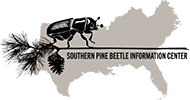Abstract
The southern pine beetle, Dendroctonus frontalis Zimmerman (SPB), and eight of its hymenopterous parasites were studied to evaluate the effects of SPB density and tree bark thickness (BKTH) on the parasites.
Significant differences between infestations were found for densities of Dendrosoter sulcatus Muesebeck (Braconidae), Heydenia unica Cook and Davis (Pteromalidae), Rhopalicus sp. (Pteromalidae), Roptrocerus xylophagorum (Ratzeburg) (Torymidae), and SPB. Roptrocerus xylophagorum and SPB varied similarly among infestations. Parasite and SPB densities were generally highest at midbole of infested trees and decreased toward the ends. The male-to-female ratio for Roptrocerus xylophagorum was 1.7 to I, this being the only parasite observed to depart from a I:I sex ratio.
Rhopalicus sp. density increased linearly with SPB density and decreasing BKTH. Roptrocerus xylophagorum density was linearly related to SPB density and BKTH, and an SPB density-BKTH interaction was found. Spathius pallidus Ashmead (Braconidae) density was not related to SPB density but increased quadratically with decreasing BKTH. Coeloides pissodis (Ashmead) (Braconidae) and Cecidostiba dendroctoni Ashmead (Pteromalidae) displayed inverse density-dependent responses to SPB density, and linear responses to BKTH. Dendrosoter sulcatus, H. unica, and Eurytoma spp. (Eurytomidae) exhibited inverse density dependent responses to spa density, and quadratic responses to BKTH.
